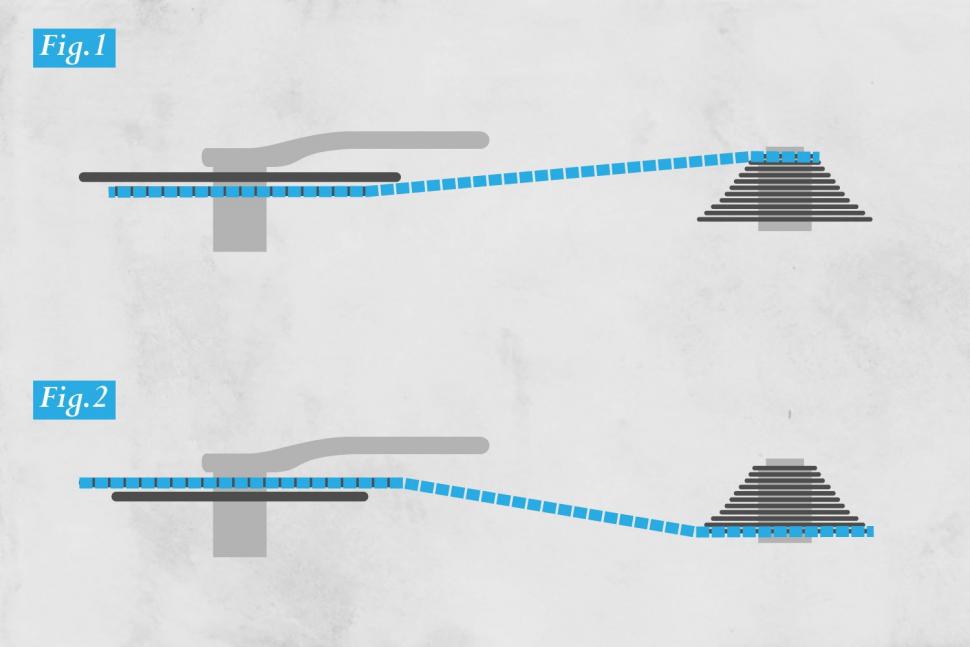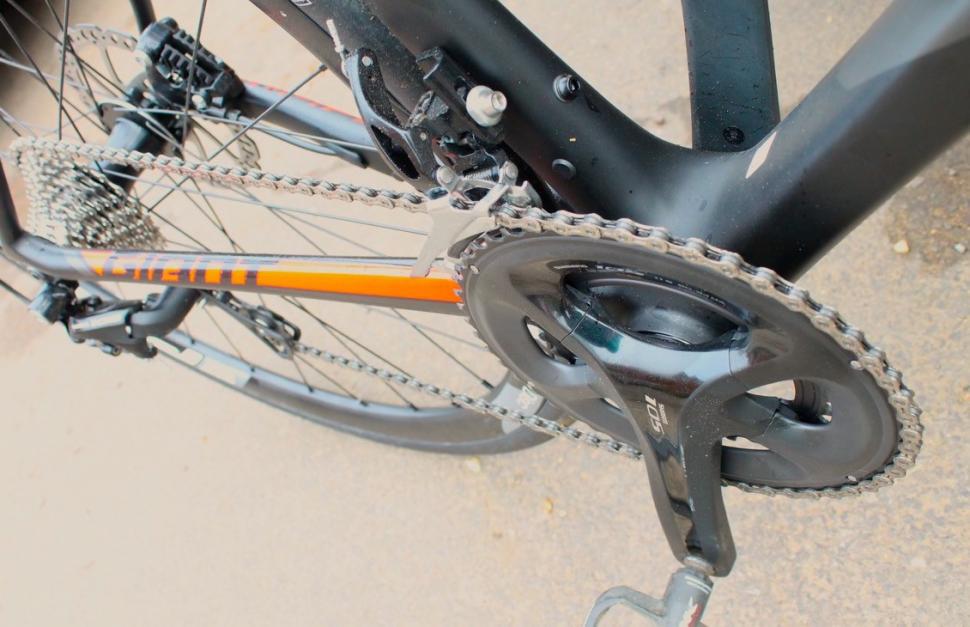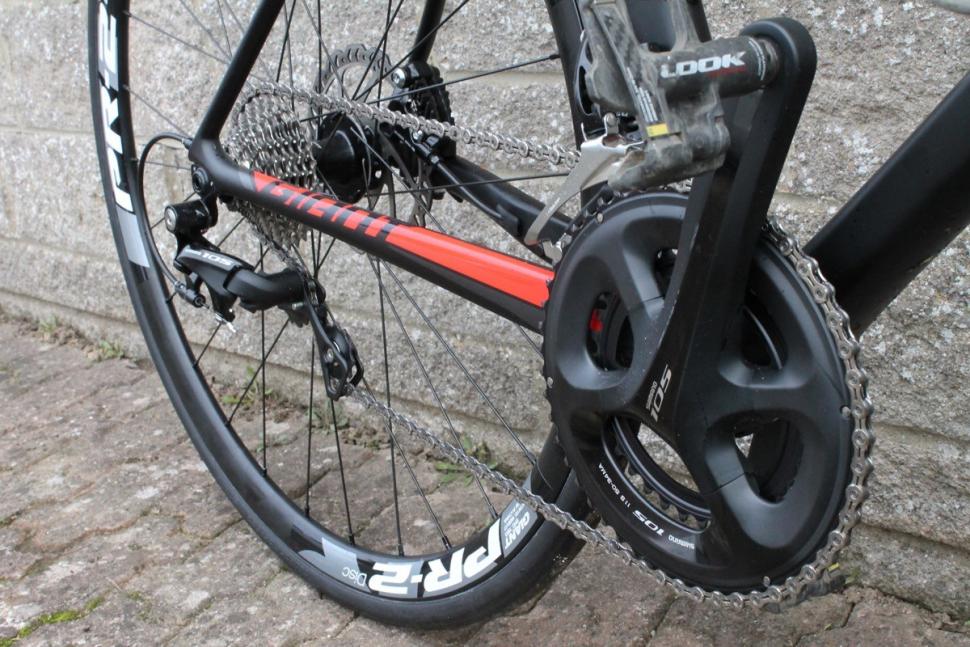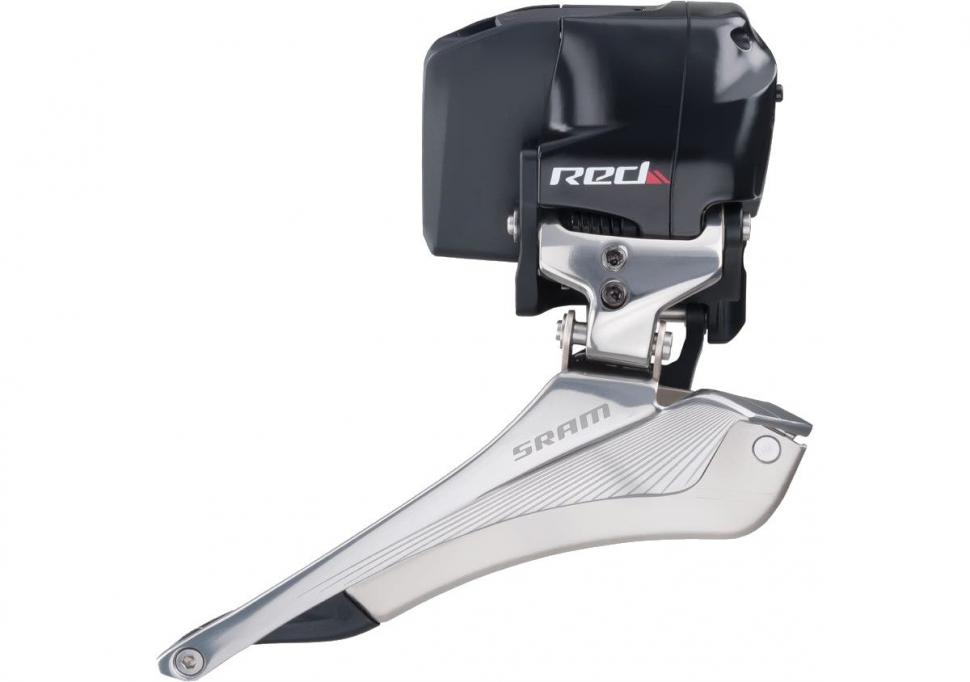- News
- Reviews
- Bikes
- Accessories
- Accessories - misc
- Computer mounts
- Bags
- Bar ends
- Bike bags & cases
- Bottle cages
- Bottles
- Cameras
- Car racks
- Child seats
- Computers
- Glasses
- GPS units
- Helmets
- Lights - front
- Lights - rear
- Lights - sets
- Locks
- Mirrors
- Mudguards
- Racks
- Pumps & CO2 inflators
- Puncture kits
- Reflectives
- Smart watches
- Stands and racks
- Trailers
- Clothing
- Components
- Bar tape & grips
- Bottom brackets
- Brake & gear cables
- Brake & STI levers
- Brake pads & spares
- Brakes
- Cassettes & freewheels
- Chains
- Chainsets & chainrings
- Derailleurs - front
- Derailleurs - rear
- Forks
- Gear levers & shifters
- Groupsets
- Handlebars & extensions
- Headsets
- Hubs
- Inner tubes
- Pedals
- Quick releases & skewers
- Saddles
- Seatposts
- Stems
- Wheels
- Tyres
- Health, fitness and nutrition
- Tools and workshop
- Miscellaneous
- Tubeless valves
- Buyers Guides
- Features
- Forum
- Recommends
- Podcast
feature
 crosschain.jpg
crosschain.jpgIs cross-chaining disastrous? Find out what the manufacturers say
Generations of cyclists have known that cross-chaining is A Bad Thing. It's one of those rules you get taught very early on. Ride with the chain on the small chainring (on the chainset, the component your pedals are attached to) and the smallest sprocket on the cassette (the cluster of cogs attached to the hub of the rear wheel) – as in fig 1 above – or on the large chainring and the largest sprocket – as in fig 2 – and anyone you're riding with is likely to alert you to the fact in seconds. People love to point it out.
But is cross-chaining really all that bad, or does it just get a bad rap? We asked some of the biggest component manufacturers for their views. You might be surprised at some of the things they said.
Read more: When should I replace my chain?
Shimano
The most efficient chain line occurs when the chain is running in a straight line. This minimises friction. When you run big-big you're pushing an uneven power transmission to the rollers, plates and bushings, especially at the points where the chain line alters (the points where the chain meets the sprocket and the chainring). This uneven load causes extra friction which increases the wear on the chain and longer term leads to less than optimum gear shifting.
For these reasons Shimano recommends avoiding extreme gear positions.
Ben Hillsdon, PR Officer, Shimano Europe
Shimano says you should avoid running the chain in this big-big combination (above).
Campagnolo
Cross-chaining is a practice to be avoided as it is less efficient than a straighter chainline (increased friction, less free motion of links etc).
We all might find ourselves cross-chaining during the heat of the battle during a race. However, we shouldn't make a habit out of it as there is generally a similar metric development gearing position available on a larger/smaller chainring.
Extreme chain crossing can add wear and tear on chainring and cassette teeth as the severe angle of the chain brings the external or internal part of the chain in direct contact with chainring/cassette teeth as opposed to a straight chainline which keeps friction to a minimum and limits contact to the rollers located on the axles of each chainlink.
Joshua Riddle, Press Manager, Campagnolo
Read our guide to understanding gears.
SRAM
At SRAM we love big-big. Amongst mechanics on the NORBA and Mountain Bike World Cup circuit (many years ago!), we called big-big the 'pro gear’, because professionals would ride it all the time, no matter what their mechanics told them. The same applies to pro road racers. They'll stay on the big ring as long as possible.
There are very good reasons to stay on the big chainring, even as far as the big sprocket:
• Chain management on rough terrain.
• Access to tallest gears without have to shift in front.
• Front shifts are slower than rear and much harder on the chain.
So we would encourage your readers to ride big-big if they like, as long as they don’t experience chain rasp on the front derailleur cage. SRAM 2x11 drivetrains, specifically the Yaw front derailleurs, are designed to accommodate this.
Very little efficiency is lost when cross-chaining. And in the case of big-big, minuscule efficiencies lost to cross-chaining are offset by efficiency gained because of larger bend radii for the chain. Better chain management and easier access to tall gears certainly outweigh any efficiency loss.
A few words on efficiency measurements. There are enormous differences between the efficiency measured on a loaded drivetrain and an unloaded drivetrain (what your hand feels when spinning the crank on a bike in a workstand). The sluggishness that cross chaining sometimes appears to cause on a bike in the stand disappears when the drivetrain is under load. It’s analogous to lubes in loaded and unloaded mechanical systems. Light oil generally feels better than heavy grease when a system is worked by hand, but when the system is loaded the heavier lube will be more efficient.
Similarly, cross-chaining is not a concern for premature component wear unless of course your chain is wearing through your front derailleur.
JP McCarthy, Road Product Manager, SRAM
Check out our beginner's guide to groupsets here.
FSA
In the last decade cross-chaining has become increasingly common with many people running the chain in the big chainring and big sprocket, especially with the advent of electronics which is much more permissive regarding cross-chaining.
This means that today's chains are subjected to much higher stresses than in the past. That’s why we decided to invest in the development of much stronger chains.
We have a stable supply of raw materials allowing us always to offer a product with a very high level of reliability and performance.
Here at FSA we understand well the importance of cross-chaining. Our latest introduction in this field is the 48/32 Adventure chainset. This is a new super compact standard that allows combination like 48/21 – 48/18. It’s a possible solution to avoid crossing because the chain works more linearly.
We will have this new range of chainsets available in 2017, from the carbon SL-K to our entry level Vero Pro.
Maurizio Bellin, General Manager, FSA
There's a range of views from the big brands, then; what do you think? Is cross-chaining perfectly acceptable? Or do you avoid it because of greater inefficiency and component wear and a higher chance of dropping your chain? Let us know your thoughts and experiences.
Mat has been in cycling media since 1996, on titles including BikeRadar, Total Bike, Total Mountain Bike, What Mountain Bike and Mountain Biking UK, and he has been editor of 220 Triathlon and Cycling Plus. Mat has been road.cc technical editor for over a decade, testing bikes, fettling the latest kit, and trying out the most up-to-the-minute clothing. He has won his category in Ironman UK 70.3 and finished on the podium in both marathons he has run. Mat is a Cambridge graduate who did a post-grad in magazine journalism, and he is a winner of the Cycling Media Award for Specialist Online Writer. Now over 50, he's riding road and gravel bikes most days for fun and fitness rather than training for competitions.
Latest Comments
- brooksby 21 min 47 sec ago
What fresh devilry is this??? - perhaps they had a design for some handlebars, and another design for some forks, and somewhere along the line the...
- brooksby 25 min 26 sec ago
And finally: I wonder how many of the "more than 3,000" signatures on that petition are actually locals, who live or work there (and are not just...
- Matthew Acton-Varian 35 min 6 sec ago
Lucky too - if they misjudge their cut and hit the battery... you'll be scraping their charred remains from the windows of next door.
- Doug_D 2 hours 1 min ago
Another book suggestion - I can highly recommend "Lost Summers and Half-Forgotten Afternoons: A Mint Sauce collection" - a beautifully presented...
- chrisonabike 3 hours 13 min ago
But... the last is only not the case with drivers on normal roads because driving on the cycle path / footway / rolling a vehicle up there is seen...
- mdavidford 3 hours 51 min ago
I think you're missing an opportunity to pack even more tech into it - add accelerometers that can detect whether they're pedalling or stepping....
- chrisonabike 4 hours 16 min ago
Thanks. I guess the question is "need". If the road is busy, it sounds like it is a desired route between places? In which case (given this an...
- mdavidford 4 hours 24 min ago
Don't know what you mean. I thought my suggestion was entirely practical.
- Rapha Nadal 4 hours 59 min ago
I'd buy a motorbike fo rthat kind of money!





Add new comment
145 comments
I often cross chain
It does not complicate it
noise does not bother
oh wait, wrong thread...
Does anyone know any figures that show the loss of efficiency on cross chained? I suspect it's a lot less than shaving your arms.
My personal take is that cross chaining 'myths' come from back in the day when I started racing and a 6 speed cluster was a new, crazy boundary pushing idea. The chains then were much wider and stiffer in the sideways movement, and there werent' shaped teeth and you were more likely to get snagging and chain wear in cross chained. Nowadays with the narrower more mobile chains I'm pretty sure it's not a real issue. Campy and Shmano have nothing to lose by toeing the line of 'well, this has always been best advice' whereas SRAM with 1 x 12 has something to gain bygoing the other way. Both Campy and Shimano' s answers revolve entirely around the efficiency argument. I'd be really interested to know what the figures are on that.
Why do manufacturers give you the option to do it if their kit won't stand up to it?
I'm running crumby Sram Apex (10 speed) and I've noticed there's a trim shift on the big chain ring but none on the small. Makes sense! Glad I read this piece, thanks.
Its interesting that the two companies with the smoothest, most precise chains and chainrings are not recommending cross-chaining. The two companies that don't manufacture as strict tolerances don't seem too concerned about it.
Personally I'd go with the Shimmy & Campy recommendations.
Has anyone done any definitive lab tests under controlled conditions? Shouldn't be too hard - just time-consuming and a tad expensive.
My personal opinion is that additional wear on the chain would not be significant. I rather suspect the main effect is greater wear on chainrings and sprockets with the angled chain rubbing more on the sides and edges of the teeth.
Too many uncontrolled, unmeasurable variables to use personal experience as evidence.
Cheers
Adrian
It is indeed, and one of those where embedded bias and experience and prejudice lead to entrenched positions. I'm happy my position that it doesn't really matter is spot on. Can I prove that? Nope
chains are chains and putting them under unneeded stress will prematurely wear them. SRAM are shameless in taking this as an opportunity to market their front derailluers. Pros have a ready supply of high quality components and mechanics to replace them. I dont.
It is a stateement of the bleedin obvious that cross chaining should be avoided, butyit should not spell disasterif you ocassionally do it.
I used to be in a club where the old sweats would change onto the small ring in late October and not use the big ring again until the chainys started in spring. They'd spend all winter tutting at those that used the big ring and making gloomy prognostications about averaging faster than 16mph over 60 cold miles....
A bunch of us started going out in the big ring and blasting 40 mile intervals instead. It soon became a committee issue and we ended up leaving the club.
I run a compact these days so tend to use only a couple of cogs on the back anyway on most rides.
fascinating eh?
As a bike mechanic I often see the results of cross chaining, the wear and tear is dreadfull. Absolutely every part is running at an angle and thus getting more strain and less efficiency. One other point I haven't seen mentioned is the fact that there is an overlap in the gears meaning there will be a more suitable and efficient gear in there somewhere so why do it?
Over 80 posts on cross chaining? Riding much this winter, people?
Y'know the Shimano shifters with indicators on?
Lots of snobbery against them, but I think they are/were a good idea. Not only did it prevent cross chaining (as it's easier for me to see something on the shifters in front of you than glancing down) but I found it useful to help newbies. Saying to keep the indicators in reasonably the same place on meant they didn't take their eyes off the road to figure out what gear they're in.
Always thought it was a shame they didn't install something similar in higher end groupsets. I still don't like looking back to check which gear I'm in.
Frequently on the big-big on my road bike (50x32) but never small-small and it seems that Shimano are inviting me to cross-chain that with the half-click on the front derailleur.
Occasionally big-big on MTB (44x32) if I know the hill is short but less often because the triple chainring means there's more potential for wear on the front derailleur cage
Big-big. Often, especially when climbing in the big ring (52) and you need to get over the top and not lose speed.
Small-small. Never, unless I forget.
Right, so I think I have got it now.
This is the synopsis of what I think I have learnt from this:
Do I have this right?
How does this article, updated
by Mat Brett March 24 2017
differer from the orginal one published 3 months ago?
"That's why I stopped to 8 gears, and would never use less than 2 front chainring. It also means my chain works on most non-pro bikes and any shops stocks it.
Sometimes when you have perfection, you look for any reason to run away for it just because you want "innovation", when in fact you are going backward."
.... and you're still afraid of sailing off the edge of the flat world, right?
i fitted a sram groupset last year and i have to admit that of all of its features i was most skeptical of the yaw function and was prepared to dismiss it as a gimmick.
I've subsequently done about 4000km (mostly in nice weather) on the same chain with no strong tendency to avoid small-small or big-big and have occasionally appreciated the flexibilty to hold a gear, rather than worry about needing to change rings. I generally use the straightest chainline i can, but i have sometimes been sitting in the same gear for a long time before realising its fully crosschained.
I get less than half that distance out a chain on a winter bike which gets coated grit and muck, so i'd be inclined to think that the dominant factor in chain wear is drivetrain cleanliness, with any acceleration of wear due to crosschaining being relatively small in comparison.
From the greasy end of things..... we mechanics eliminate as much rub and noise as possible and sometimes there is none at all at the extremities... when they leave the workshop.... how you ride is your call....
when they leave the workshop.... how you ride is your call....
repeated article
A couple of things that have yet to be mentioned;
Firstly, as I am naturally a 'spinner' (have a high cadence) I very rarely need the large ring on my compact double UNLESS I am pedalling over 25mph! Yes, we are all different individuals and anything below 85rpm feels such hardwork to me.
Finally, using the large ring might be lower friction-wise, but what about the actual force needed on the pedals? in my mind the smaller ring needs lesss force due to leverage principles (e.g. when using a wheelbarrow for example, when the weight is closer to the wheel (bottom bracket/chain tension) and the handles are further in distance from this point (crank arm/pedal) it is easier to lift. So for the same load, the small ring generates more torque and it then follows that for the same gear inches it requires less force on the pedals, how much does the greater friction reduce this advantage? also the momentum of the cranks and the mass of my legs spinning at high revs provides a sort of flywheel, making any change in terrain easier to float over. Combined with smaller gaps between the next gears in either direction I find this much more comfortable, but each to their own!
I'm with Campag/ Shimano mechanics on this - don't do it. Have some mecahnical sympathy!!
I think some of the practice stems from a reluctance to shift the front rings, particularly when you need it to happen very quickly. I gather this is less of an issue with electronic, though that potentially encourages more wear simply because it will perform with extreme chainlines and shifting under load.
On my good bike I currently run 10s Campag 52/39 and the 13t gap between them, being relatively small, allows for a very fast, smooth and trouble-free shift at the front. Together with being able to instantly jump up or dump 3/5 cogs respectively at the back, plus a short cage carbon RD, means the whole thing is over very quickly and without drama.
Those running compacts, and/or big tooth differences at front/ rear, with groupsets from the other manufacturers might be more worried about losing rhythm, dropping a chain etc, which is less of an issue with my current set up.
Pros do it all the time. Not a big deal.
my own 2cts.. on sram big-big is a lil nicer due to yaw derailleur, though it still use the chain faster than not crossing thats for sure.. but its really not that big of a deal. worse care you'll change the chain 1 week earlier? it also tend to not be all that bad on my cassette since its the big ring its stronger and takes less load anyway.
Back to Jerome's comment, when cross chained the transverse component of the force applied to the rear cog by the chain is lost to friction and heat. If you were in big/big then this loss could be roughly 4cms/35cms or roughly 10%, its simple physics and i think is covered in the bicycle science publications pretty comprehensively ( where they then argue hub gears arent so bad compared to a cross chained derailleur setup)
What would be really useful is a magazine to do some scientific tests using chainset and hub powermeters to measure the differences in various gear combinations.
The manufacturors will never admit to to 10% worst case losses because it makes their products look bad. Compacts were introduced to save money over triple setups but are really really bad when it comes to befinners cross chaining and snapping chains and dropouts.
Real world 1 - Tech heads 0
Gotta love the SRAM guys....
Click bait.
Cross chaining, qu'est que c'est la? Oh, hang on, a very old person is just whispering something in my ear... Ahhh, right, got it.
Only one possible response really - google the phrase '21st century', you'll be amazed.
How often is this article gonna get recycled?
How bad cross-chaining is depends on the load. If I'm riding up a mountain on my touring bike then the noise from even middle front to big rear is not encouraging and will wear out parts of the drivetrain prematurely. Without the load on the flat that ratio is fine.
Also with an MTB chainline, I found that after some months commuting, accelerating hard away from standstill middle front to big rear weakened and ultimately snapped the chain because the sideways force pushed the plates off the pins.
Pages